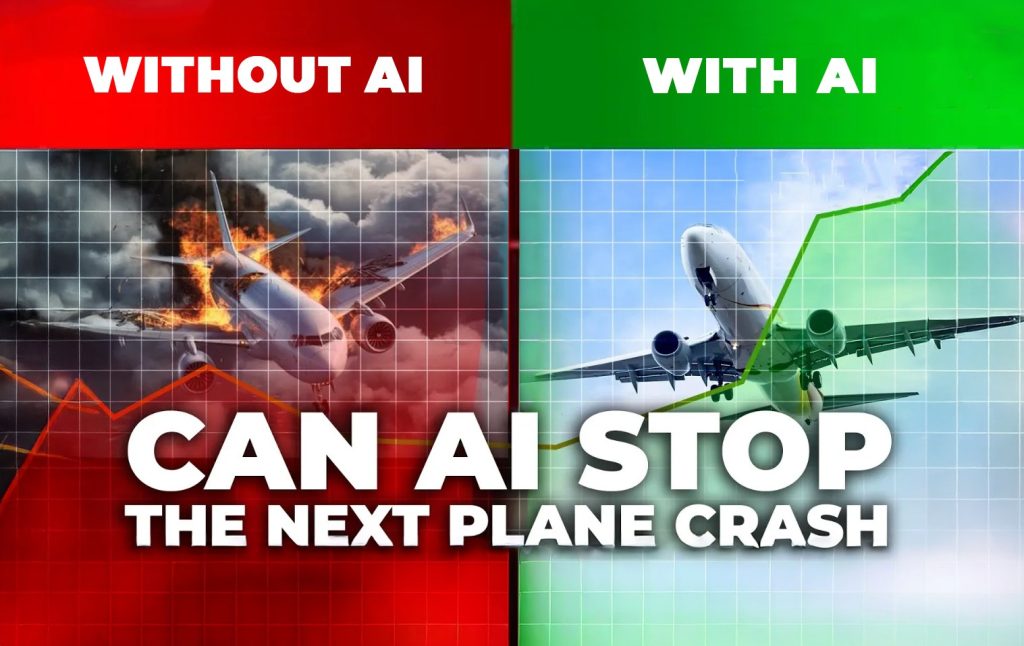Can AI Prevent the Next Plane Crash Before It Happens?
Meet the Co-Pilot That Could Save Your Life
Every now and then, we see heartbreaking news about a plane accident—tragedies that cost hundreds of lives and shake the world.
A single mechanical glitch… a missed signal… and 300 lives are gone.
But what if a silent co-pilot could spot danger before humans even notice?
Can artificial intelligence (AI) really prevent the next plane crash? You’re about to find out.
The Problem
Air travel is statistically one of the safest ways to travel. In fact, flying is safer than driving, cycling, or even walking. Yet when something does go wrong, the consequences are catastrophic.
From pilot error and mechanical issues to bad weather and communication failures, aviation accidents often result from a chain of events. Despite rigorous training and strict protocols, over 70% of aviation accidents still involve human error (Li, Chen, and Zhang 2).
Pilots are trained. Systems are robust. But the sky remains unpredictable.
This is where AI could make a difference
Enter AI: Your New Co-Pilot
AI isn’t about replacing pilots—it’s about amplifying them. Unlike humans, AI doesn’t get tired, doesn’t panic, and doesn’t overlook tiny warning signs. Instead, it tracks thousands of parameters in real time, detects anomalies before they escalate, and even monitors the pilot’s condition.
In fact, a prototype AI system recently flagged a hydraulic issue six minutes before the pilot even noticed, allowing the flight to divert safely (Airbus).
From Boeing to Airbus to NASA, aviation leaders are actively testing AI copilots. Even the U.S. Air Force has run missions with AI assisting in the cockpit.
So how exactly can AI reduce risks in the sky?
How AI Can Help
Predictive Maintenance
AI can analyze massive amounts of flight data—engine performance, vibration levels, oil pressure—and predict system failures before they occur.
Delta Airlines already uses predictive analytics to prevent delays and reduce maintenance-related risks (IATA).
Real-Time Flight Monitoring
Think of AI as a digital co-pilot. It monitors flight dynamics, pilot inputs, and aircraft systems, flagging anomalies invisible to the human eye.
Weather Pattern Analysis
Using decades of meteorological data, AI can forecast turbulence, storms, and wind shear far better than traditional methods, helping pilots chart safer flight paths (NOAA).
Pilot Condition Monitoring
AI can monitor a pilot’s voice, gestures, facial expressions, and biometrics to detect signs of fatigue, stress, or confusion. Such systems are already being tested in cockpits (Reinhardt and Kelly 19).
Real-World Applications
This isn’t science fiction—AI is already flying with us.
- Airbus Skywise collects flight data from over 10,000 aircraft to predict failures and enhance safety (Airbus).
- Boeing Autonomy Core is being tested for automated operations in commercial jets.
- NASA’s X-57 Maxwell project is experimenting with AI for autonomous flight systems (NASA).
These tools aren’t meant to replace human pilots. Instead, they combine human judgment with machine precision, creating the potential for the safest aviation era in history.
The Future of Safe Skies
Imagine boarding a flight, knowing that alongside your pilot is an invisible AI co-pilot

—watching every vibration, every engine pulse, every shift in the wind.
If AI can prevent even one tragedy in the sky, it’s worth embracing.
So the next time you fly, remember: the future of aviation safety may already be sitting silently in the cockpit, safeguarding your life.
For further assistance, visit our channel and refer the video
Can AI prevent plane crashes ? | How Artificial Intelligence could save lives in the sky.

References
- Airbus. Skywise: The Open Data Platform for Aviation. 2023. www.airbus.com.
- Federal Aviation Administration. Human Factors in Automation. FAA.gov, 2021.
- International Air Transport Association (IATA). Predictive Maintenance and Big Data. 2021.
- Li, Y., Chen, H., and Zhang, W. “Human Factors in Aviation Accidents: A Data-Driven Analysis.” Journal of Air Transport Management, vol. 102, 2022, pp. 102115.
- NASA. X-57 Maxwell: Leading the Way Toward Fully Electric Aircraft. 2022. www.nasa.gov.
- National Oceanic and Atmospheric Administration (NOAA). Artificial Intelligence for Weather Prediction. 2023. www.noaa.gov.
- Reinhardt, K., and Kelly, M. “Biometric Monitoring in Commercial Aviation.” IEEE Aerospace and Electronic Systems Magazine, vol. 36, no. 7, 2021, pp. 18–25.
Share This :


